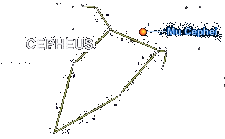The diameter of... |
| "A Matter of Scale" - The Video |
This is a tour that starts with Mercury and ends at the largest known stellar object.
You may have already seen this clip on various sites like YouTube. It was the impetus behind this micro-documentary. All I did was mix down a new soundtrack.
If, after watching this short movie, you are not changed in some way, then you are one of the following:
a) Extremely enlightened
b) Unflappable
c) A pumpkin |
|
 Earth Earth
12,756km
Carl Sagan's poignant description of earth as a "mote of dust, suspended in a sunbeam" is as apt a summarization as I've ever heard.
"That's here. That's home. That's us. On it, everyone you ever heard of, every human being who ever lived, lived out their lives. The aggregate of all our joys and sufferings, thousands of confident religions, ideologies and economic doctrines, every hunter and forager, every hero and coward, every creator and destroyer of civilizations, every king and peasant, every young couple in love, every hopeful child, every mother and father, every inventor and explorer, every teacher of morals, every corrupt politician, every superstar, every supreme leader, every saint and sinner in the history of our species, lived there on a mote of dust, suspended in a sunbeam."
There is a sad, lonesome tone in Sagan's summary of our planet that I can certainly understand. Humanity really is just beginning to realize (or at least come to grips with) the universe around us. Its vastness is crushing or inspiring depending on one's point of view. Rather than whisper forlorn narratives into the night, a crushed poet, I've chosen to be inspired. And frightened. But mostly inspired.
|
Jupiter
142,984km
About 990 Earths could fit inside Jupiter. Imagine the volume of Earth multiplied by 990 (and that still wouldn't entirely fill up Jupiter). That's how big Jupiter is...Bigger than 990 Earths all stacked into a sphere. The current population of the earth (6.6 billion) could expand to 6 trillion, 534 billion (6,534,000,000,000) with plenty of elbow room left over.
A perpetual storm on Jupiter's equator called the "Big Red Spot" would entirely engulf the Earth. Twice.
From our point of view, Jupiter is indeed an impressive object. |
Sol (our sun)
1,392,500km
Sol dwarfs Jupiter, and when Earth is compared to it, we're just a speck. While every planet in the solar system could fit inside Jupiter, it would take over 900 Jupiters to fill Sol. If you stacked enough Earth-sized marbles (each 12,756km in diameter) to match the volume of our sun, you would need over 1 million marbles.
Sol's size, compared to our home planet, is truly enormous. But at least we can picture it. Sun=huge, Earth=speck.
Now let's venture outside our solar system... |
Sirius
2,506,500km
As impressive as is our Sol, Sirius is much larger, easily eclipsing it. However, when you look at the two side by side, they're still respectable neighbors, not all that different really, perhaps the difference between a basketball and a grapefruit. When describing Earth, however, the term "speck" ceases to have any meaning now as things start to get a little scary.
Pollux
6,962,500km
Pollux is an order of magnitude larger than Sol and his brother Sirius. A brute at 9 times the diameter of our sun, it is also 32 times brighter. In fact, it is the brightest star in the constellation Gemini. Jupiter is relegated to "speck" status.
Arcturus
41,77,500km
Sol, representing our solar system now since the rest of our planetary bodies have long since receded into obscurity, would be just about invisible by now. All the energy of every type that has ever been generated in our solar system is lost within the orange furnace of Arcturus.
Rigel
86,335,000km
We've moved beyond the realm of meaningful comparisons now. As we travel farther, less is available in experience (or possibly spirit) to describe what we find.
Beteigeuze
905,125,000km
"-whether they be thrones, or dominions, or principalities, or powers: all things were created by Him, and for Him." (Col 1:16) Principality or brain crushingly huge star. I see no discernible difference at this point.
Antares
1,108,380,000km
Okay, maybe there is still one meaningful comparison to be made. We orbit our sun at a distance of about 146,000,000km. Antares' diameter is itself more than 7 times larger than that.
...and there are other bodies still larger. Two that we know about are named...
Mu Cephei
3,481,250,000km
VV Cephei
3,676,200,000km
These two stars are incomprehensibly large. Mu Cephei, a red supergiant,
has begun to pulsate and fuse helium to carbon, which means it is dying. VV( that's V V )Chephei is the largest known star. It, too has brothers deep in the stellar darkness. VY Canis Majoris, KW Sagitarii, V354 Cephei, and KY Cygni are all nearly as large as VV Cephei.
Mu Cephei is visible with the naked eye on earth. From here, its 3,481,250,000km girth is just a brighter speck in the sky. And one day soon, cosmically speaking, it will die in a supernova explosion.
From here, if this event happens at all during the entire lifetime of our planet, observers on Earth will suddenly see a bright point of light that might last a few days, then go dim and finally vanish. One of the largest deep space objects known to man, a speck no more.
Matter of scale, meet matter of perspective.
|
|
|
|
|
 Earth
Earth 